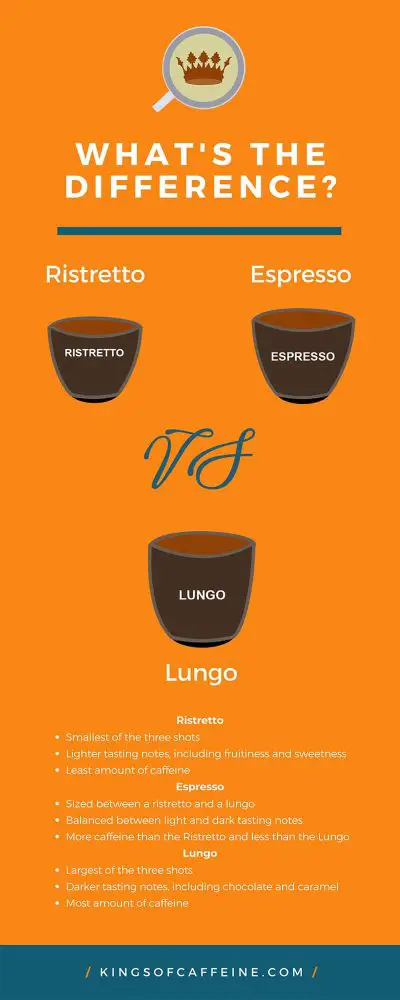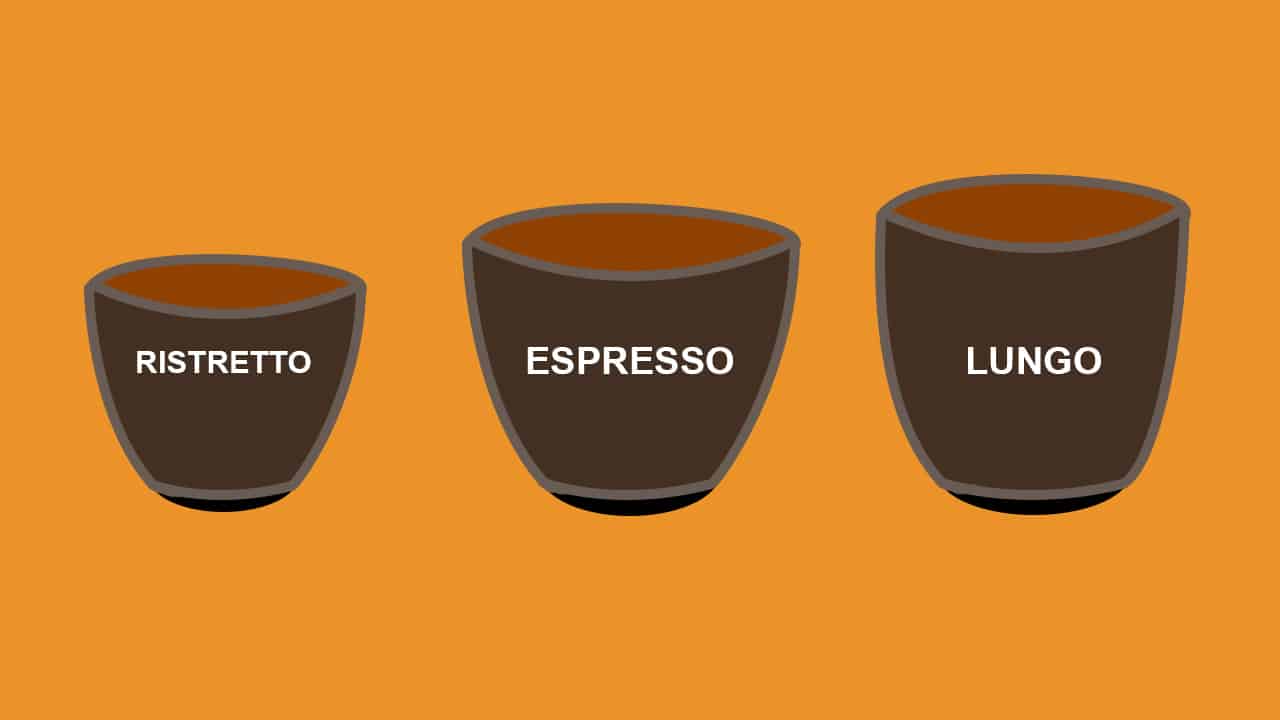Everyone is familiar with Espresso, but do you know what a Ristretto or a Lungo is?
To put it into context, Espresso is the Justin Timberlake of the coffee world, everyone knows who he is! But, do you know Lance Bass or JC Chasez? Of course not! No one does.
In this short article you’ll find out what’s the difference between an Espresso, Ristretto and a Lungo and everything else you need to know about the coffee shots.
Unfortunately, I won’t be diving any further into information on NSYNC members as it is no longer 1999, so you’ll just have to live with that.
Now, let’s begin!
Skip to a section:
Espresso makes up the base of most coffee drinks we regularly buy from our favourite coffee shops, such as Cappuccinos, Flat Whites, Lattes and more.
In basic terms, Espresso is a coffee brewing method where pressure is used to force near boiling water through finely-ground coffee to produce a 30ml beverage.
Below is an abridged version of a comprehensive article we’ve written, where we go deep into Espresso and how to make the perfect Espresso which you can read HERE!
The process of producing a great Espresso begins with fine grinding a dosage of coffee into a portafilter, making sure to weigh the grounds (I usually aim for 18g coffee grounds).
Coffee grinders we love!
Next, level out the coffee and compact it in the portafilter with a tamper. This is done by pressing the tamper directly down, on top of the coffee grounds. Ensuring an even spread of coffee will guarantee water passing through the grounds will travel at the same speed regardless of where it penetrates.
Tampers we love!
The portafilter is placed back on the machine where near boiling water (approximately 94°C) is then forced through the coffee (at about 9 bars of pressure). This is also referred to as the ‘extraction’.
The extraction time, that is the amount of time the water is being pumped through the coffee, drastically changes the flavour of the Espresso shot and is usually between 25 – 35 seconds.
To be more specific, to work out the exact extraction time you require, you first need to work out the brew ratio. The brew ratio is the weight of dry coffee that is used, compared to the weight of liquid Espresso that is produced.
An Espresso commonly has a brew ratio of around 2:1, so if 18 grams of dry coffee was used, this would mean producing an Espresso that weighed 36 grams (without the cup of course).
So then the extraction time is the time it takes to achieve the brew ratio and this depends on the grind size of the beans, the finer the grind the slower the water will move through, remembering that we want an extraction time of approximately 30 seconds.
This is a balancing act and different variations will produce different tasting Espressos. This is where I leave it with you to test different beans, brew ratios and extraction times and see how it all affects the flavour of the final shot. Everyone is different so find out which combination you like best.
Once again, we have written a deep dive into Espresso and how to make the perfect Espresso which you can read here!
A good Espresso is a full-bodied coffee shot and has quite a complex taste. It has a perfect balance of bitterness, sweetness and acidity; the flavours are bold and the finish is long.
A good Espresso should never taste sour, overly bitter or watery and should have a syrupy mouthfeel.
Crema is the light brownish coloured foam that commonly sits on top of an Espresso and although it has its controversies it is commonly viewed as a good indicator of high quality Espresso.
The production of crema is a combination of a couple of elements. The first being that after coffee is roasted it will begin to let off CO2 for a small period of time. Some of this CO2 is released when the water is pushed through the ground coffee producing small bubbles. At the same time this process releases some of the coffee’s oils and other molecules, the molecules help stabalise and reinforce the bubbles, preventing them from popping immediately and the oil mixes into the foam helping enhance its creaminess.
Ristretto means ‘shortened’ or ‘narrow’ in Italian and is in fact a shortened shot of Espresso, usually 15ml in total volume. Some people like to remember a Ristretto as a ‘restricted’ Espresso shot, as about half the water is used in producing a Ristretto than an Espresso and about half of the extraction time, which can be around 15 seconds.
A Ristretto commonly has a brew ratio of around 1:1, meaning if 18 grams of dry coffee goes in, 18 grams of liquid Ristretto would come out.
The reduction in water and extraction time affects the overall taste and mouthfeel in a variety of ways.
Lighter tasting notes such as fruit and sweetness appear earlier in the extraction process than more bitter flavours like chocolate and caramel, so by cutting the process before the darker notes develop you are dramatically altering the taste of the shot.
A quicker extraction will also produce a slightly thicker mouthfeel than the Espresso.
To finish off the trio, the Lungo is the longer version of the Espresso shot and it will be no surprise that Lungo translates to ‘long’ in Italian, usually 60ml in total volume
Lungos typically utilise a brew ratio of around 1:3, so if 18 grams of dried coffee was used, this would produce a Lungo weighing approximately 54 grams. To achieve this a Lungo usually has double the amount of water than an Espresso and double the extraction time, approximately 50 to 70 seconds.
The addition of water and extraction time affects the overall taste by bringing in more of the deeper, more bitter tasting notes discussed earlier, such as chocolate and caramel.
The longer extraction will also produce a slightly less thick mouthfeel than the Espresso.
For some people how much caffeine is in their coffee is the most important factor. The caffeine concentration in an Espresso, Ristretto and a Lungo is as follows:
- Lungo (most caffeine content)
- Espresso (2nd most caffeine content)
- Ristretto (least caffeine content)
The reason for this is simple, the longer the extraction the more total coffee compounds (caffeine is one of these) make it into the cup. As the Lungo is extracted the longest it has more time to release caffeine into the resulting drink.
In summary the differences between the three beverages are listed below:
Ristretto
- Smallest of the three shots.
- Lighter tasting notes, including fruitiness and sweetness.
- Least amount of caffeine.
Espresso
- Sized between a ristretto and a lungo.
- Balanced between light and dark tasting notes.
- More caffeine than the Ristretto and less than the Lungo.
Lungo
- Largest of the three shots.
- Darker tasting notes, including chocolate and caramel.
- Most amount of caffeine.

Share this Image On Your Site
That’s it, thanks for reading!
As always if you have any questions or feel like we have missed anything please send your questions/suggestions to [email protected]
Small Notice
If you click on any of our Amazon links and make a purchase, we earn a commission at no additional cost to you!









